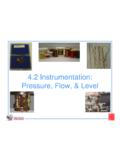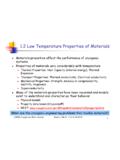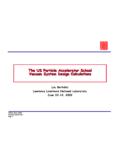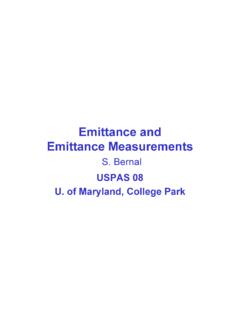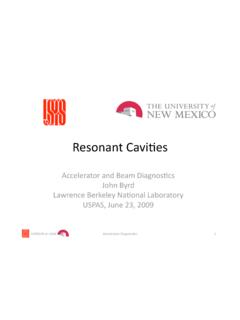Transcription of Refrigeration Liquefaction - Fermilab
1 Refrigeration & Liquefaction Outline Recuperative systems Ideal Refrigeration / Liquefaction Joule Thomson expansion System analyses: 1st and 2nd law applied to:Simple Linde-Hampson cycleVariations and improved performance cyclesClaude and Collins cyclesIdeal Refrigeration / Liquefaction Moving heat from a cold reservoir to a warm reservoir requires energy dW dQc dQh In an ideal process, the entropy associated with the two heat flows is the same, that is: The amount of heat moved is associated with an amount of entropy by the relationship: In an ideal process the amount of work (energy) required to move the heat is dW = dQh dQc Ideal Cool Down Extracting an amount of heat to lower the temperature of (whatever) by dT, and releasing the heat at Th: Including the temperature dependence of the specific heat, the ideal cool down work becomes: Compare this to the amount of energy required to warm up the same mass: dQ dQ dQ dQ dQ dQ dQ T dQ/dT dW/dT Ideal Liquefaction To cool down a parcel of gas, and convert it from saturated vapor to saturated liquid at its normal boiling temperature: Re-arranging terms we have: Work to extract latent heat Work to extract sensible heat Temperature dependent specific heat Or, in the rate form.
2 Ideal Liquefaction Phigh T S Vapor dome Plow 1 2 f Th 1 f 2 f 1st law: Energy balance around system: In steady state, the sum of the energies into and out of the system = 0 A 1st-law, 2nd-law analysis around an ideal cycle reveals the same expression 2nd law: Entropy balance around system: In steady state, the sum of the entropies into and out of the system = 0 Combining,we have: 0 Note the SI units of h(kJ/kg) and s(kJ/kg-K) Ideal Refrigeration In steady state, the 1st law around the whole system gives: 1 3 2 4 The 2nd law around the compressor gives: The 2nd law around the evaporator gives: Combining, and noting that s1=s4 and s2 =s3 we have: The coefficient of performance (COP) for the refrigerator is then Ideal Liquefaction / Refrigeration Ideal Liquefaction work for cryogens (from Barron) Comparison with ideal performance defined by Figure of Merit (FOM), for Refrigeration sometimes referred to as % of Carnot.
3 Practical Limitations Not possible to achieve ideal-scenario pressure Inspect T-S diagram: find lines of constant pressure, constant enthalpy, constant density, vapor dome Estimate required pressure for ideal Liquefaction of nitrogen Isentropic expansion is very difficult to achieve. Isenthalpic (or throttle) expansion is very easy to achieve Cooling associated with throttle process exploits real-gas properties. Note that at high T, low P, h is independent of pressure, but elsewhere it is not. Joule-Thomson Coefficient 1885 - Joule & Thomson (Lord Kelvin) confirm that a gas flow through a restriction experiences a temperature drop along with the pressure drop. P The Joule-Thomson coefficient: characterizes the phenomenon. When j>0, cooling accompanies a pressure drop.
4 Regions of positive and negative j are reflected in T-S diagrams and inversion curves: T S h plow Tc pc phigh Above the inversion temperature, we have j < 0 for all pressures. Pre-cooling is required for helium (Tinv=45K), hydrogen (Tinv=205K), and neon (Tinv=250K). P/Pc T/Tc 10-12 Tinv j >0 T >0 j < 0 T(p-1) < 0 Simple Linde-Hampson Cycle Inversion temperature must be above compression temperature, or pre-cooling via a higher temperature refrigerant liquid is required. Recuperative heat exchanger pre-cools high pressure stream. Liquefier requires source of make-up gas. refrigerator absorbs heat converting liquid to vapor at saturation temperature of low pressure. Makeup gas m Q R Compressor Heat exchanger Liquid Liquid reservoir 1 1 1 2 3 4 g Joule - Thomson valve f m f W Simple Linde-Hampson Cycle In steady state conditions, the 1st law around the compressor gives: The 2nd law around the compressor gives: (Note the assumption of isothermal compression) Combining, we have: Applying the 1st law around everything except the compressor gives: Defining yield, and combining with compression work gives: Simple Linde-Hampson (JT) refrigerator Applying 1st law (energy balance) to everything except the compressor gives: Makeup gas Compressor Heat exchanger Liquid evaporator 1 1 1 2 3 4 g Joule - Thomson valve W Combining with the expression for the compressor work provides an equation for the COP.
5 Comparing with the Carnot COP gives the FOM (or % of Carnot): Example: Linde-Hampson w/ Argon Performance at 20 MPa: h1 = h2 = s1 = s2 = Performance at optimized P h2 = s2 = 349 J/g 315 J/g J/g-K J/g-K 298 J/g J/g-K Linde-Hampson Performance Optimum theoretical performance realized by minimizing h2 (P2 such that h is on the inversion curve) P2 is typically ~ 100 atm. Theoretical performance with P2 = 20 atm.(from Barron): Linde-Hampson Cycle Enhancements Pre-cooled L-H cycle Optimize performance via pressure, pre-cooling temperature and mass flow ratio FOM increased by ~ factor of 2 Dual-pressure L-H cycle Optimize performance via two pressures and fractional mass flow ratio FOM increased by ~ factor of (From Barron) (From Barron) Claude Cycle: isentropic expansion Isentropic expansion, characterized by s=dT/dPs (always >0) results in larger temperature drop for a given pressure drop than with isenthalpic expansion 1st and 2nd law analyses give: Optimize performance by varying P2, T3, and x.
6 Claude Cycle: Variations Kapitza cycle Low pressure (7 atm) production of liquid air Regenerative heat exchanger Heylandt cycle High pressure (200 atm) air Liquefaction Room temperature expander (From Barron) (From Barron) Collins Liquefier Introduced by Sam Collins (MIT) in 1952 Optimized performance via expander flow rates and temperatures LN2 pre-cooling increases yield by factor of 3. (From Barron) Commercial Helium Liquefier The dashed line encloses the cold box, everything except the compressor. Find the expansion engines Trace the flow from LN2 precooler through the cold box to the JT valve. Influence of Non-Ideal Components A non-ideal heat exchanger will have an effectiveness less than 1. 1 1 2 T 3 3 S g A non-isothermal compressor will require more work than an isothermal compressor The influence of these non-ideal parameters on the cooling capacity ( refrigerator ), liquid yield (liquefier), and compression work for a simple Linde-Hampson system is.
